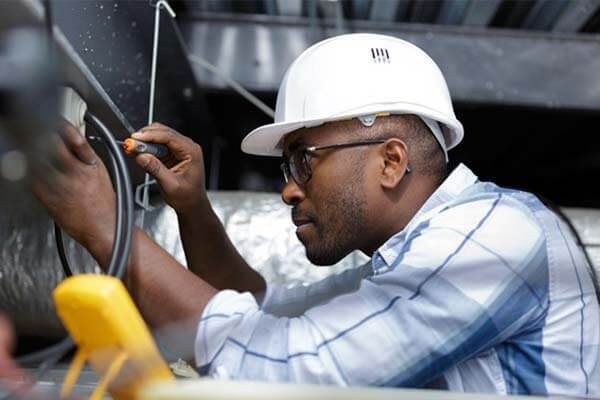In modern commercial buildings, the electrical systems serve as the nervous system, controlling lighting, HVAC, security, and even data systems. With the optimization of buildings as the primary focus, a commercial electrical contractor is now a pivotal member of the optimization team, thanks to advancements in technology. Today’s electrical professionals shape operational environments, enhance energy efficiency, promote occupant comfort, and support productivity to support business goals.
Today’s commercial electrical systems integrate smart technologies, making HVAC, automated lighting, and data systems much more interconnected and complex. For a business to gain an advantage over their competition, the electrical contractor needs to ensure optimal power distribution, as well as have working knowledge of the automated systems, energy management, and performance metrics of the buildings.

The Evolution of Commercial Electrical Systems
In comparison to the past decade, commercial buildings now have more complex systems. Simple lighting circuits and basic power distribution are relics of the past, as modern buildings require more sophisticated systems to accommodate the needs of the business. With smart technologies such as advanced power management systems, not only can energy consumption be optimized in real-time, but automated systems can also adjust lighting and natural light availability can be utilized as well.
Because of technological advances, electrical contractors can now function as consultants capable of understanding how various electrical systems influence a structure’s overall efficiency. Today’s electrical contracting jobs, for example, modern electrical contractors jobs near me, demand specialists who can devise elaborate plans and complex systems for the functional efficiency of a building. Moreover, sustain the environment and keep occupants of the building content.
New optimization avenues for contractors have been opened by the incorporating of advanced Internet of Things (IoT) and construction building automation systems with sleep mode functions. Contractors well-versed with these technologies can offer building owners tremendous energy savings while enhancing the user experience and improving energy efficiency by as much as 30% in operational costs.
Power Distribution: The Foundation of Optimal Performance
Every high performing commercial structure heavily relies on effective power distribution. A properly configured electrical distribution system provides dependable power supply while reducing energy waste and improving system efficiency. This efficiency optimization can be achieved by performing load calculations, power factor correction, as well as the distribution and switchgear position and placement.
Modern commercial buildings often need sophisticated strategies for power distribution to cater to varying loads, renewable energy sources, and even backup power systems. The best electrical contractor near me knows how to design distribution systems with foresight. These systems need to adapt to future requirements without major infrastructural changes.
The increasing prevalence of sensitive electronic equipment in commercial spaces makes power quality more critical than before. Equipment performance and lifespan can be severely affected by the voltage fluctuations, harmonics, and power factor issues. Professional electrical contractors leverage power conditioning, uninterruptible power supplies, and harmonic filters to maintain high-grade power throughout the facility.
Advanced Switchgear and Protection Systems
The center of any commercial electrical system revolves around its switchgear and protection equipment. Modern switchgear systems come with advanced monitoring; power consumption can be tracked, issues can be predicted, and electrical systems can be fine-tuned. These systems use intelligent protection devices with fault isolation capability, reducing equipment downtime and safeguarding expensive devices.
Medium voltage switchgear is critical for large commercial installations with complex power distribution needs due to their superior voltage control, reduced transmission losses, and enhanced system reliability. The implementation of control and monitoring systems integrated with switches also allows for predictive maintenance, improving system durability and performance.
Energy Efficiency Through Smart Electrical Design
The responsibility, both for the environment and economically, has made energy efficiency a priority for commercial building managers. Electrical contractors can help implement energy-saving measures that improve a building’s energy efficiency while also ensuring the comfort and productivity of the occupants.
The implementation of LED lighting systems is one of the most impactful energy efficiency enhancements for commercial buildings. The replacement of traditional lighting with LED systems only captures a small portion of the potential energy savings. With the aid of control systems that are advanced and use occupancy sensors, daylight harvesting, and automation through scheduling, lighting energy use can be reduced by 60 to 80 percent in comparison to conventional systems.
Addressing poor power factors in energy usage through automatic power factor correction suggests an additional avenue for energy optimization. Power factor correction facilities in commercial buildings incur additional expenses while straining the electrical infrastructure. Hiring electrical specialists streamline power factor correction by refining reactive power use and cuts down demand expenses.
Variable Frequency Drives and Motor Control
Motors control an estimated 45% of electrical energy in commercial buildings, putting commercial motor control systems at the core of energy optimization. With motors operating at full capacity by default, Variable Frequency Drives (VFDs) that allow demand-based speed adjustment boost energy savings by 20-50% for HVAC fans, pumps, and other motor-driven equipment.
Motor Control Centers (MCCs) use VFDs and advance speed control by default, enabling demand-based optimal speed operation. Centralized monitoring of multiple motor circuits allows for smart motor control providing multi-circuit motor demand control and advanced strategy implementation—all while monitoring motor performance and warning of potential malfunctions. Benefits include energy efficiency, lowered maintenance, and boosted reliability.
Building Automation and Control Systems
The optimization of building automation systems offers some of the greatest potential in improving the performance of commercial buildings and facilities. Integrated HVAC, lighting, and security automation systems function to continuously provide and maintain the most favorable building environmental conditions and economize on resource use.
To a great extent, the modern building management systems are reliant on the electrical systems of the building to provide adequate coverage in terms of sensors, controllers, and communication networks. Its support is critical to streamlining commercial electrical systems. Companies that deal with commercial electrical systems appreciate the vital role that power and signal distribution play in the overall performance of the building.
Deployment of IoT smart sensors in a building facilitates the collection of huge volumes of data that, when subjected to analysis, assists in the optimization of the building. With the growing need to operate commercial facilities more efficiently, the facility managers now have the tools that allow them to monitor and manage critical facility functions such as energy use, occupancy, and equipment performance.
Integration of Renewable Energy Systems
Renewable energy sources are becoming more common in commercial buildings, making it necessary for electrical contractors to understand the integration challenges. For example, solar photovoltaic systems include inverters, monitoring systems, and grid-tie equipment that interface with the existing electrical infrastructure. These components require advanced sophisticated coordination.
Grid-tied systems and battery storage systems offer backup power during outages, lower peak demand charges, and operate independently from the electrical grid. However, energy storage systems require advanced battery management systems and power conversion equipment, adding to the existing complexity.
Maintenance and Performance Monitoring
Preventive maintenance has evolved from a simple visual inspection to more advanced diagnostic and predictive analytics. For example, monitoring and power quality systems. Thermal imaging cameras identify hot spots in electrical connections and power quality analyzers detect faults that could impact sensitive equipment.
Smart meters, protection relays, and electrical monitoring systems provide real-time operational data. Modern electrical systems generate large amounts of data, optimizing performance, predicting maintenance needs, and analysis. These systems enable proactive maintenance strategies that reduce equipment downtime, extend lifespan, and preserve equipment.
With the introduction of computerized maintenance management systems (CMMS), electrical contractors are able to maintain logs for system maintenance and usage, evaluate system performance data, and refine maintenance schedules based on the actual condition of the equipment instead of on arbitrary time thresholds.
Safety and Code Compliance in Performance Optimization
Safety will always be a primary concern for building performance optimization, and it should always be aligned with code compliance requirements. An electrical contractor operates in a very highly regulated environment with the need to maximize building performance, and because of that, they need to know the national electrical codes, local regulations, and the industry standards very well.
Among the electrical code regulations that are essential for system performance and safety are: the Arc Fault Circuit Interruption (AFCI) and the Ground Fault Circuit Interruption (GFCI). Both of these protective devices are essential for the maintenance of electrical fires and electrical shock, and they also provide invaluable feedback about circuit performance and system reliability.
Through the systematic regular electrical safety audits and the infrared thermographic inspections, proactive approaches for safety management can be enhanced to maintain a building’s reliability and performance. These proactive approaches help to identify safety and system performance concerns early on to avoid system compromises
Future Trends in Commercial Electrical Systems
The electrical contracting industry is facing changes because of technology advancements, new regulations, and increased focus on sustainability. The use of artificial intelligence and machine learning is growing in building automation systems. These new technologies allow for more sophisticated optimization strategies that can change automatically.
Transportation electrification presents new issues and opportunities for commercial electrical contractors. The installation of electric vehicle charging stations is problematic. These charging stations must be properly planned and implemented because they can overload existing electrical systems.
Another promising opportunity includes microgrids, enabling commercial buildings to separate more from the traditional electrical grid. These systems need advanced control systems, energy management strategies, and smart technologies that electrical contractors must learn and implement.
Conclusion

A commercial electrical contractor’s role has changed. Their focus is to improve building performance and optimize the business’s operations. Electrical contractors remain critical to business success by advanced power distribution systems.
The scope of commercial electrical systems today is much more complicated than before. A modern electrical contractor’s work goes beyond routine installation. To modernize a building and optimize its performance, an electrical contractor requires knowledge of energy management, building automation, as well as advanced control systems and power quality.
For more than 75 years, IET has remained the go-to electrical engineering company in East Africa, serving the regions of Kenya, Uganda, and Tanzania. IET has always been on the forefront in providing innovative building performance solutions. With our excellent in scope knowledge in power transmission and distribution, building automation, motor control systems, and energy management, we stand as a perfect commercial electrical partner. IET possesses a team of trained professionals that can design and install electrical systems in any planned or existing facility that ensure efficiency, cost reduction, and performance enhancement. Get in touch with IET today. Let our commercial facility electrical infrastructural transformation consulting and engineering unveil potential through our unmatched expertise.
